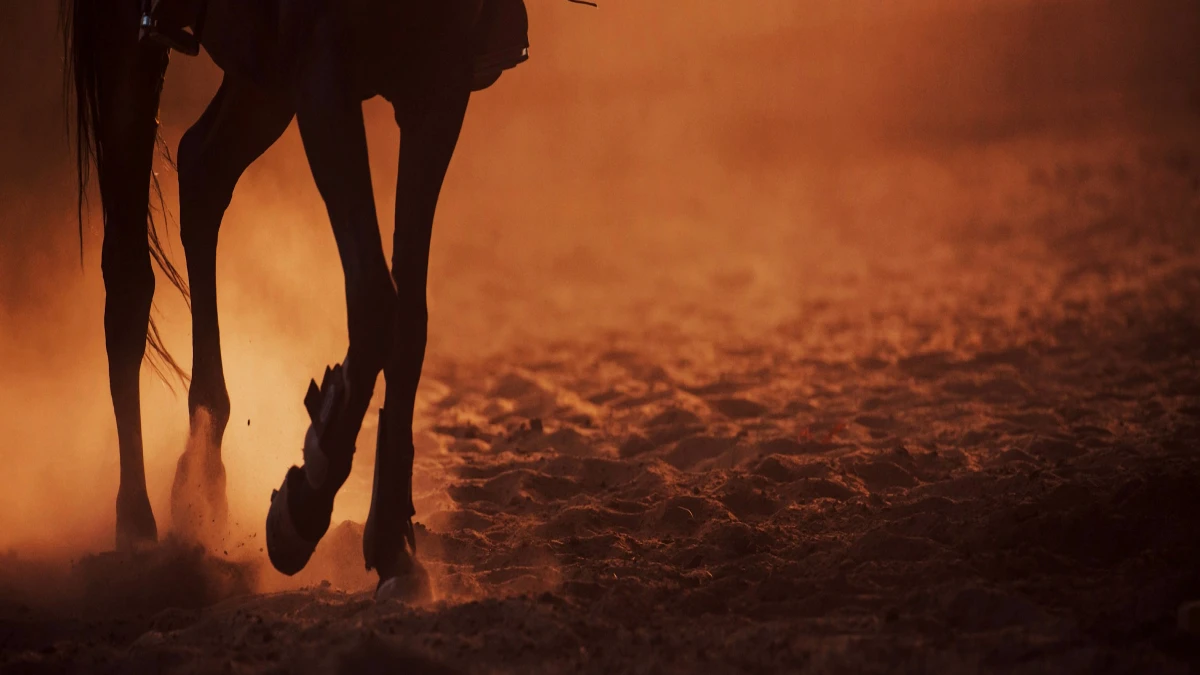Weaving in Horses: Causes and Management
Jul 22, 2023 by Jamie Finch

As horse owners, trainers, and caretakers, it's of utmost importance to comprehensively understand the various behavioural issues that can affect our equine companions.
One such concern is "weaving," a repetitive and compulsive behaviour some horses display when confined in stalls or enclosures.
This blog post will delve deeply into the causes, impact, and management techniques associated with weaving to promote a thorough understanding and proactive care for our beloved horses.
What is Weaving in Horses?
Weaving, also known as stall weaving or cribbing, is a stereotypic behaviour in which a horse sways or rocks back and forth from side to side while standing in its stall.
This rhythmic and repetitive movement pattern often responds to stress, boredom, or other underlying issues.
When a horse weaves, it typically places one front hoof against the stall wall or door. It pushes its body back and forth, creating a distinct and easily recognisable motion.
Identifying Weaving in Horses
Detecting weaving in horses is crucial for early intervention and providing appropriate care.
Some common signs of weaving include:
Swaying Motion: The horse exhibits a noticeable swaying or rocking motion while standing in the stall, often following a regular and predictable pattern. This rhythmic movement distinguishes weaving from other occasional shifts in weight.
Front Hoof Movement: A weaving horse repeatedly places one front hoof against the stall door or wall and pushes its body back and forth. This repetitive action can cause physical wear and tear on the stall, leading to visible marks or damage.
Vocalisation: Horses may vocalise more frequently while weaving, which could indicate distress or anxiety. The sound of their vocalisation might vary depending on the individual horse.
Physical Signs: Over time, the repetitive weaving can result in wear on the horse's hooves and uneven stress on its legs, potentially leading to hoof and leg-related issues.
Differentiating Weaving from Normal Behaviours
It's crucial to distinguish weaving from regular movements that horses may exhibit in confinement.
While some horses may shift their weight or move slightly in stalls, weaving is characterised by its repetitive nature and distinct back-and-forth swaying motion.
Regular movements, such as occasional weight shifts or mild pacing, typically do not follow the rhythmic and compulsive pattern seen in weaving.
By differentiating weaving from other behaviours, we can accurately identify potential issues and respond appropriately.
Common Causes of Weaving
Weaving can arise from physical, psychological, or environmental factors. Understanding these causes is essential for implementing effective strategies to prevent and manage weaving behaviour.
Some common reasons why horses may exhibit weaving include:
Stress and Boredom: Horses are intelligent and active animals that require mental and physical stimulation. Confinement without adequate cognitive engagement or social interaction can lead to stress and boredom, prompting weaving as a coping mechanism.
Social Isolation: Horses are social herd animals that thrive in the company of others. Isolation or limited contact with other horses can cause anxiety and lead to weaving as a way to self-soothe.
Anxiety and Fear: Horses exposed to stressful environments, loud noises, or sudden changes in routine may develop anxiety-related behaviours, such as weaving.
Gastrointestinal Discomfort: Some studies suggest that weaving might be associated with gastrointestinal discomfort, as horses may engage in this behaviour before or after feeding.
Learned Behaviour: Horses are observant creatures who may pick up weaving by watching other horses engage in the behaviour.
Impact of Weaving on Horses
Weaving can have significant consequences on a horse's well-being and health, affecting various aspects of their life, such as:
Physical Strain: The repetitive swaying motion can strain the horse's limbs excessively, leading to wear and tear on joints and muscles. Over time, this can result in physical discomfort and reduced mobility.
Weight Loss and Digestive Issues: The stress and anxiety associated with weaving can impact a horse's appetite and digestion, potentially leading to weight loss and other gastrointestinal problems.
Dental Problems: Horses might wear down their teeth unevenly due to the constant movement and pressure on their incisors.
Hoof and Leg Issues: Constantly pushing against stall walls may cause hoof and leg-related problems, including uneven hoof wear and stress-related injuries.
Management and Prevention Strategies
As responsible horse owners, we can implement several management strategies to prevent and address weaving behaviour:
Ample Turnout and Exercise: Ensure horses receive regular turnout in a safe, spacious paddock or pasture. Exercise and social interaction with other horses can help alleviate stress and reduce weaving tendencies.
Stall Enrichment: Provide toys, treat-dispensing balls, or hanging balls with snacks inside to keep the horse mentally engaged and prevent boredom.
Companionship: Whenever possible, house horses in groups to provide social interaction and friendship, reducing the feeling of isolation.
Consistent Routine: Establish a daily routine to help horses feel more secure and less anxious.
Addressing Stressors: Identify and address any potential stressors in the horse's environment, such as loud noises or sudden changes in the stable.
Conclusion
Weaving is a complex behaviour indicating underlying issues affecting a horse's well-being.
By gaining a comprehensive understanding of the potential causes and impact of weaving and implementing proactive management strategies, we can create a supportive environment for our horses to lead healthier, happier lives.
Each horse is unique, and a patient and compassionate approach is essential in addressing and managing weaving behaviour.
Let us work together to ensure the well-being of our equine companions and foster a positive human-horse bond built on trust and understanding. By taking a proactive stance and providing optimal care, we can create a world where weaving is rare, and our horses thrive in harmony and contentment.
Explore More Topics
Understanding Behavioural Changes in Horses
When a horse’s behaviour suddenly changes, it’s rarely without cause. This blog explores the physical, emotional, and environmental reasons behind behavioural shifts — and how owners can respond with understanding, clarity, and care.
May 31, 2025
10 Essential Groundwork Exercises to Improve Equine Agility
This blog post, "10 Essential Groundwork Exercises to Improve Equine Agility," provides a comprehensive guide for horse owners looking to enhance their horse's agility, coordination, and responsiveness through progressive groundwork. Each exercise includes step-by-step instructions, explains why the exercise is important for building trust, focus, and physical conditioning, and details how these skills translate into improved performance in agility courses and other equestrian pursuits.
Oct 28, 2024
Top Tips for First-Time Horse Owners: How Equine Insurance Can Give You Peace of Mind
Equine insurance is a crucial safety net for horse owners, providing financial protection against unexpected costs related to veterinary care, accidents, injuries, and liability claims. Whether you're a first-time owner or an experienced equestrian, insuring your horse offers peace of mind by covering expensive vet bills, public liability issues, theft, and even death.
Oct 23, 2024







